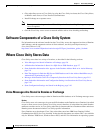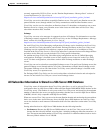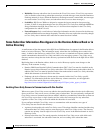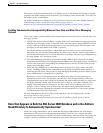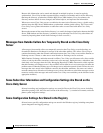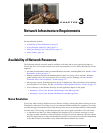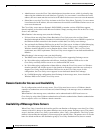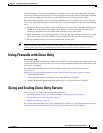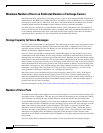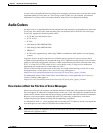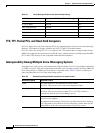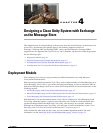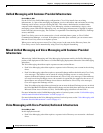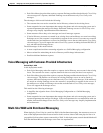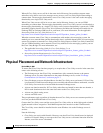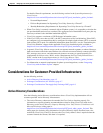
3-4
Design Guide for Cisco Unity Release 5.x
OL-14619-01
Chapter 3 Network Infrastructure Requirements
Sizing and Scaling Cisco Unity Servers
Maximum Number of Users on Dedicated Domino or Exchange Servers
You should not allow the Domino or Exchange servers to service the maximum number of Domino or
Exchange users that IBM Lotus or Microsoft allow. In addition, servers qualified by Cisco as Exchange
message store servers for use with Cisco
Unity have a maximum number of Exchange users, and the
customer should not allow the number of users on these servers to reach the maximum.
You should also be careful not to exceed the disk capacity for the information store. For example, in
order to enable recovery if the information store is corrupted, Microsoft recommends that the total size
of an Exchange information store never exceed 50 percent of the capacity of the drive on which the
information store is installed. For more information, see the Microsoft website.
Storage Capacity for Voice Messages
For Cisco Unity systems that are configured for Voice Messaging, base the server requirements on the
total number of voice storage minutes required for each subscriber. A supported Cisco
Unity server
generally provides storage for 20 to 30 minutes of voice messages per subscriber for the maximum
number of subscribers supported on that server.
For Cisco Unity systems that are configured for Unified Messaging, it is not possible to base server
requirements on the total number of voice storage minutes required for each subscriber, because the
message store also includes e-mail messages and possibly faxes. However, you can calculate the storage
requirement for the desired number of voice storage minutes and add that to the current mailbox limits.
If the customer is replacing an existing voice messaging system with Cisco Unity, it may be possible to
obtain information from the existing system on the average number of minutes of voice messages that
subscribers currently have. You can then multiply the average number of minutes by the recording size
per minute—according to the codec that Cisco
Unity will use to record messages—to arrive at the
average amount of disk space required for voice messages per subscriber.
Start with a one-to-one correlation of legacy voice messaging system to Cisco Unity. If the legacy
system handles a larger capacity than the largest Cisco
Unity server, consider splitting the legacy
subscriber population onto more than one Cisco
Unity server by extension number ranges or prefixes. It
is not necessary to segment subscribers onto backend message stores by extension number ranges or
prefixes but it may be easier to manage.
For more information, see the “How Codecs Affect the File Size of Voice Messages” section on page 3-5.
Number of Voice Ports
To determine the number and configuration of voice ports required, you can start with the existing voice
messaging system, if applicable. This may give you some idea how many ports are required for taking
voice messages, for turning message waiting indicators on and off, and for message notification.
In a Unified Messaging configuration, Cisco Unity uses telephone record and playback (TRAP), to allow
subscribers who use Notes or Outlook for voice messaging to play and record voice messages over the
phone rather than by using speakers and a microphone. This feature is especially desirable when
subscribers work in cubicles, where there is a lack of privacy. However, when a subscriber plays or
records a message by using TRAP, a port on the Cisco
Unity server is used. (No port is used when a
subscriber uses speakers and a microphone to play and record messages.) If the customer wants
subscribers to use TRAP, calculations for the total number of voice ports required will need to take this
into account.
For Cisco Unity failover, the primary and secondary servers must have the same number of ports.



